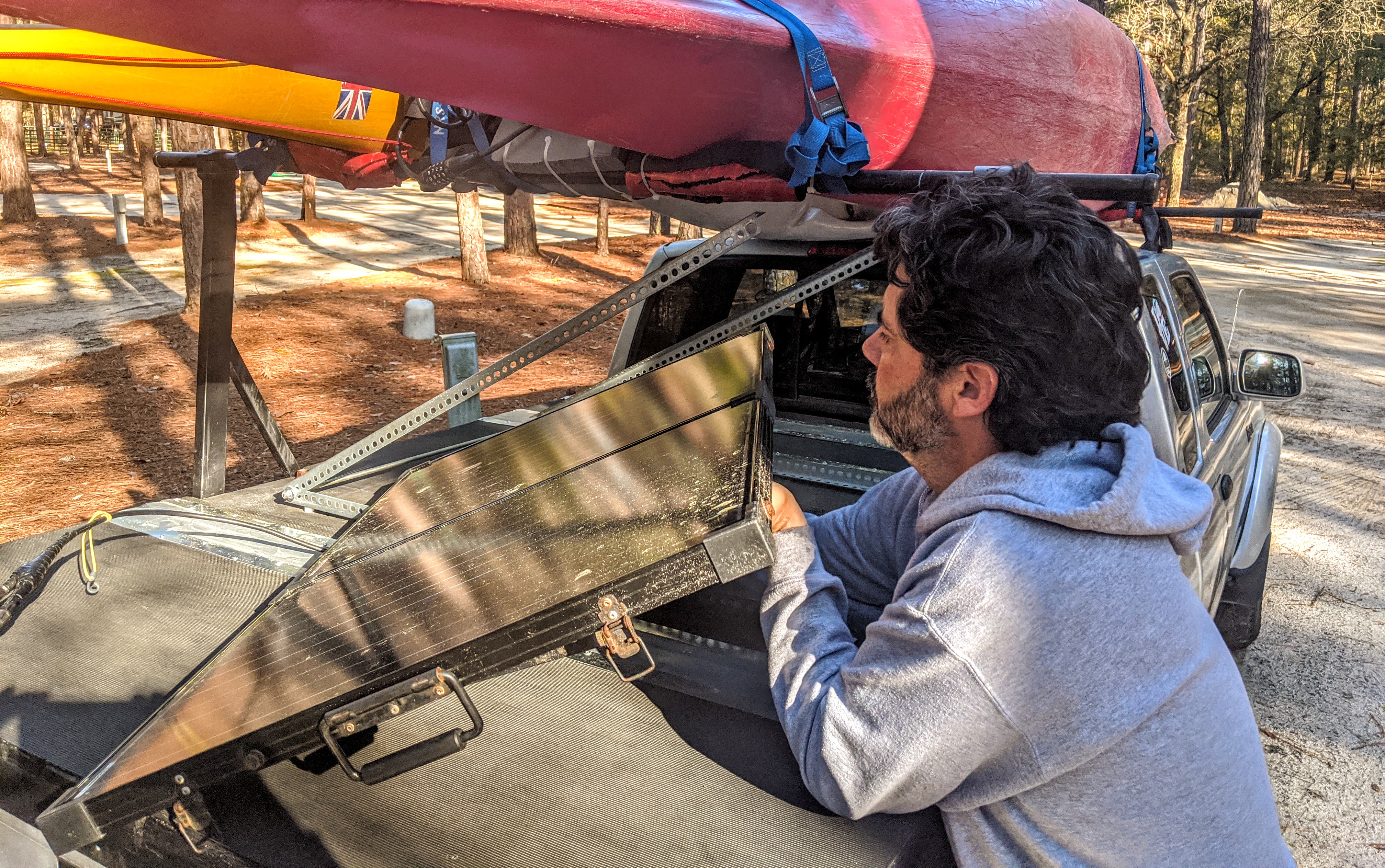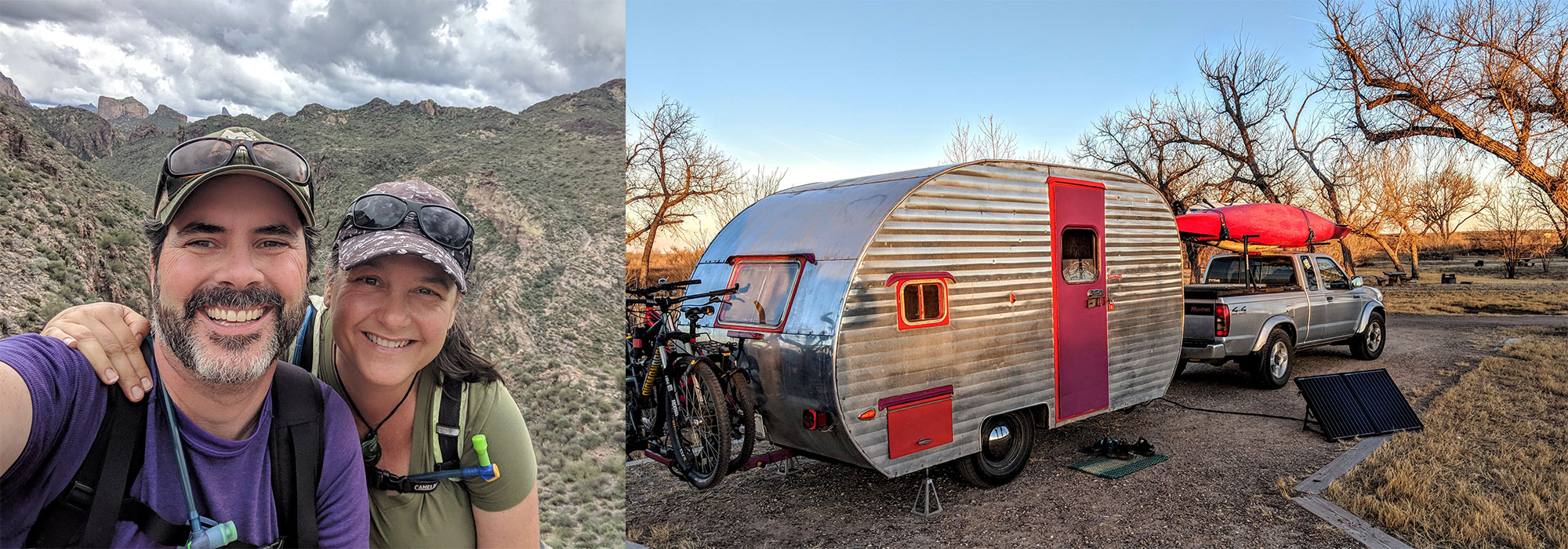Keep It Simple, Keep It Sustainable, Go Solar!
When we broke free from careers and a traditional home for an adventurous life on the road, we knew very little about the technical aspects of solar power. We are both educators, not engineers. We had many questions that were not easily answered with an online Google search at that time. Yes, in 2012 – just a mere 8 years ago – it was rather difficult to find digestible DIY information about solar technology, much less for mobile vehicles. We wondered if it was even possible for us to put solar on Hamlet, our restored travel trailer that was built during the Eisenhower administration?
We turned to our friends at IONCON, a sustainable design and engineering company in Boone, NC, for some guidance. They assured us that our dream was not only plausible, it was doable -- and we wouldn’t have to make a huge investment in time or money. They walked us through the four components of a solar powered system , provided us links to where we could order the components online, and even helped us interpret the complex wiring diagram which came with the products -- the instructions were designed for engineers, not DIYers.
Let’s just say that times have changed! Solar power is everywhere and there is a
plethora of information on YouTube and beyond.
Real estate companies and RV manufacturers are using solar as a selling
feature and solar is popping up all over the country on traditional homes, off
grid cabins, and RV’s of all shapes and sizes.
And, if you are considering going solar,
Renogy has
made it even easier and affordable to buy quality products that come with
friendly customer service and a great warranty.
Living Large While Living Small

Since the beginning, our goal has been to live as simply, minimally, and as inexpensively as possible. Over the years we have winnowed down our needs to a level that we can comfortably sustain and thrive, while working only 4 months out of each year. Adding solar to our adventure rig was the key to reaching this goal as it frees us from paying for expensive electrical hook-up campsites, making reservations, and running a noisy gas generator. We have a hybrid set-up, as we store the folding solar suitcase on the back of our truck bed cover while we are driving down the road so that we can trickle charge our battery, then set it up at a campsite when we arrive.
Solar opened the door to boondocking without sacrificing our basic electrical needs. During our first couple of years, we logged 10 full months of traveling and volunteering without needing to pay for a campsite or hook into an electrical grid. We’ve saved a ton of money and have camped in some remote and gorgeous places away from power lines and paved roads in 49 US states, 8 Canadian provinces, and more national parks and public lands than we can count.
Interested in going solar? You are not alone. To answer some of the many questions we’ve gotten about Hamlet’s solar powered system, we’ve created a tour of our solar powered system and produced various installation videos on our YouTube channel to help the average RVer with basic DIY skills. Here’s a quick synopsis of Hamlet’s electrical systems.
We have two options: 1) 12V DC solar power and 2) 120V AC shore power. We run our lives on 95% solar. When we are parked near an 120V outlet, we can plug in directly using an extension cord as a back-up, but that is very rare for us because we simply don’t need to.
We power our lives with these four Renogy components:
- 100W Folding Solar Suitcase (to capture energy from the sun)
- Wanderer Li 30A Charge Controller (to monitor the energy flowing between the panel and the battery)
- Lithium Iron Phosphate 12V/50Ah battery (to store energy for later use when it’s dark or raining)
- 700W 12V Pure Sine Wave Inverter (to change the power from DC to AC so we can run 120V appliances)
What? That’s it? Yes, that’s it. To limit the amount of solar we need to thrive, we keep our electrical needs in check with our lifestyle… simple. Here’s what we run with solar:
●LED lighting & ceiling fan
●Immersion blender & heating pad
●Recharge a smartphone, AA/AAA batteries, and other small electronics
●Recharge laptop computers
Making the Most of Living with Solar

The key to living with a small solar powered system is minimizing what needs electricity. We make great meals without the normal appliances you'd find in a traditional American kitchen! Believe it or not, we do not have a microwave, or a TV, and don't miss them at all. For coffee, we heat water and pour it into a French press, toast bread on a griddle, make waffles on an Amish waffle iron, and reheat food in a pot/pan on our 2-burner propane stove. The only electric kitchen appliance we have is an immersion blender, which we use to make smoothies, pesto, sauces, and soups. Now, this may leave you wondering if we go through a lot of propane. Nope, we spend approximately $100 per year and go through less than 25 gallons annually. It’s that simple.
Adjusting your expectations and staying flexible will help you stay happy while living mobile with solar. What happens when we have low solar gain for a couple of days and run out of power for the night? We use battery operated "puck lights" strategically placed around the camper. Or, grab some candles and a good book, or just go outside and hang out around the campfire and star gaze. It’s rare that we run out of power, but it’s very manageable…and admittingly kind of fun as it stirs those creative and resourceful fires deep in our human soul.
No matter what type of RV, Van or off-grid cabin you may have, living with solar is possible. If you have a larger rig or more power needs, check out our article about these solar powered road warriors ! If you are NEW to solar, these FAQ resources will help guide you. If you still have questions, feel free to contact us; we'll walk you through what you need or put you in touch with an engineer.

Learn more about Shari & Hutch’s solar powered adventures on their website and join them on the road via social media at Facebook, Instagram, and YouTube!








